Tesco Employee Performance: Research on Non-Monetary Aspects Impact
VerifiedAdded on 2024/05/17
|14
|2656
|74
Report
AI Summary
This research proposal investigates the impact of non-monetary rewards on employee performance at Tesco. It reviews existing literature highlighting the importance of non-financial incentives like appreciation, recognition, and opportunities for growth. The study aims to determine the relationship between job innovation and organizational productivity, the impact of job recognition on employee satisfaction, and whether non-financial rewards affect employee behavior. It employs a mixed-methods approach, primarily qualitative, using questionnaires to gather data from Tesco employees at various levels. Statistical tools will be used to analyze the data and draw conclusions about the effectiveness of Tesco's non-monetary reward systems in motivating employees and enhancing organizational productivity. The research concludes that employees are more concerned about non-monetary parameters such as job assurance, appraisal and recognition.
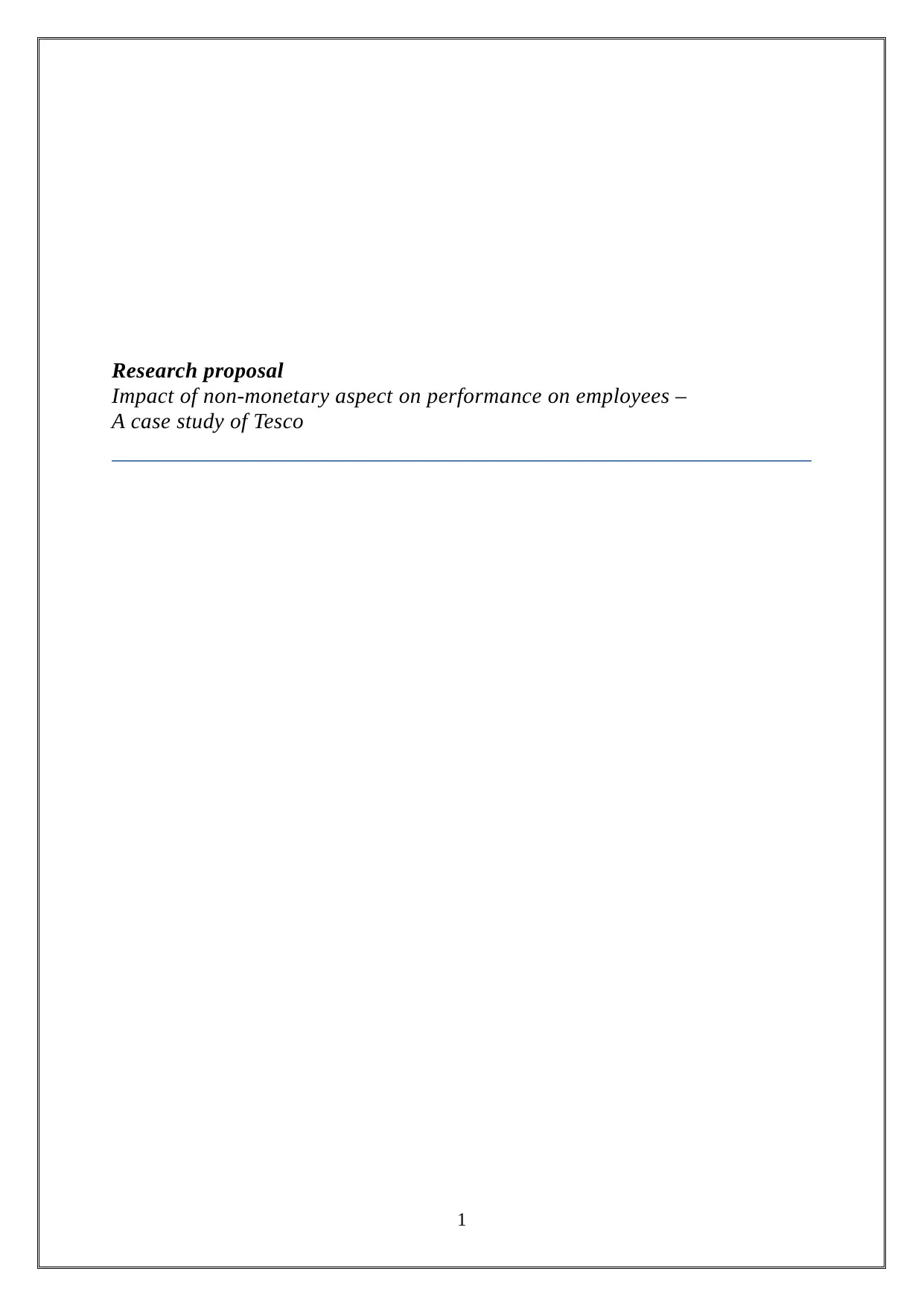
Research proposal
Impact of non-monetary aspect on performance on employees –
A case study of Tesco
1
Impact of non-monetary aspect on performance on employees –
A case study of Tesco
1
Paraphrase This Document
Need a fresh take? Get an instant paraphrase of this document with our AI Paraphraser
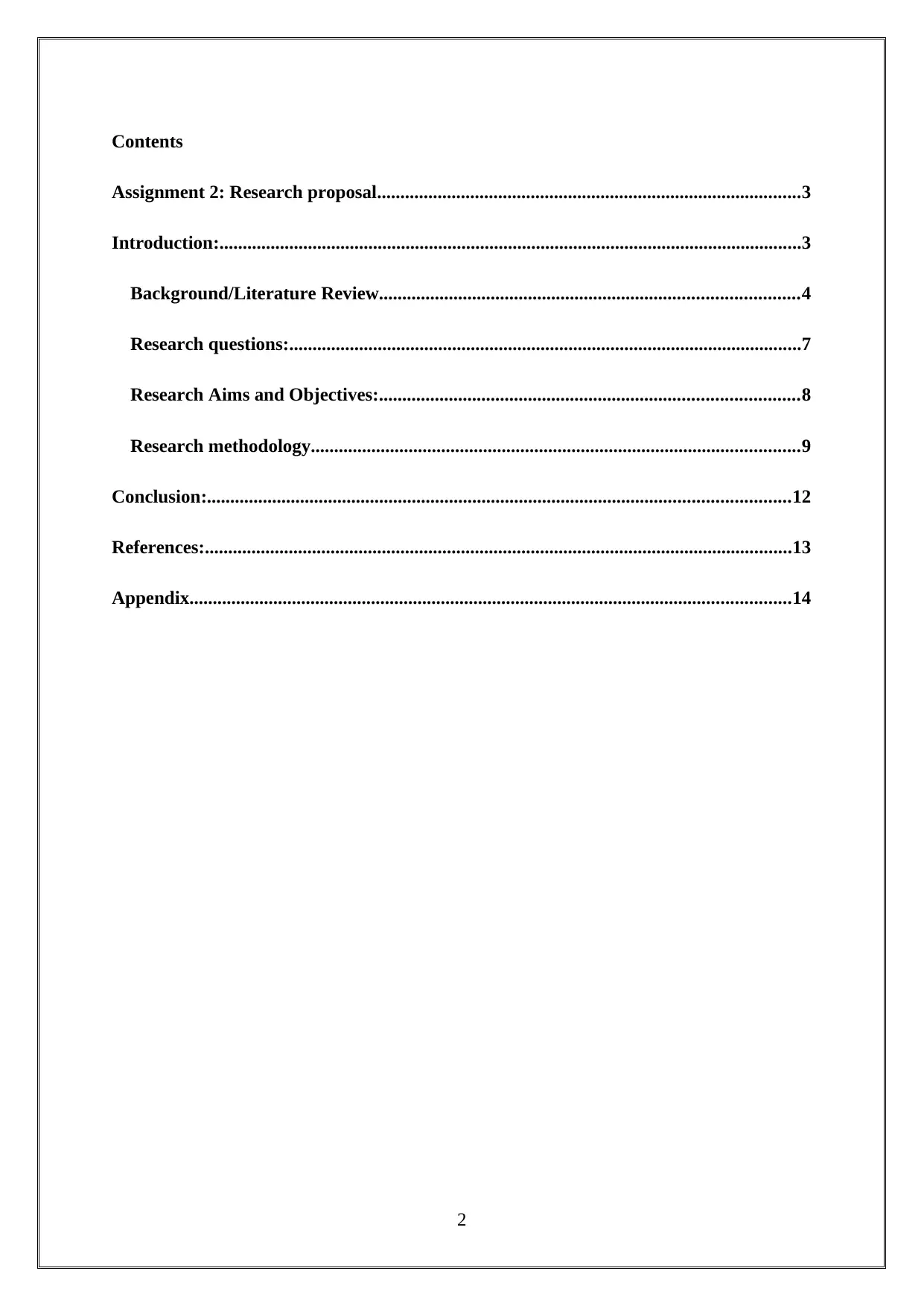
Contents
Assignment 2: Research proposal...........................................................................................3
Introduction:.............................................................................................................................3
Background/Literature Review..........................................................................................4
Research questions:..............................................................................................................7
Research Aims and Objectives:..........................................................................................8
Research methodology.........................................................................................................9
Conclusion:.............................................................................................................................12
References:..............................................................................................................................13
Appendix.................................................................................................................................14
2
Assignment 2: Research proposal...........................................................................................3
Introduction:.............................................................................................................................3
Background/Literature Review..........................................................................................4
Research questions:..............................................................................................................7
Research Aims and Objectives:..........................................................................................8
Research methodology.........................................................................................................9
Conclusion:.............................................................................................................................12
References:..............................................................................................................................13
Appendix.................................................................................................................................14
2
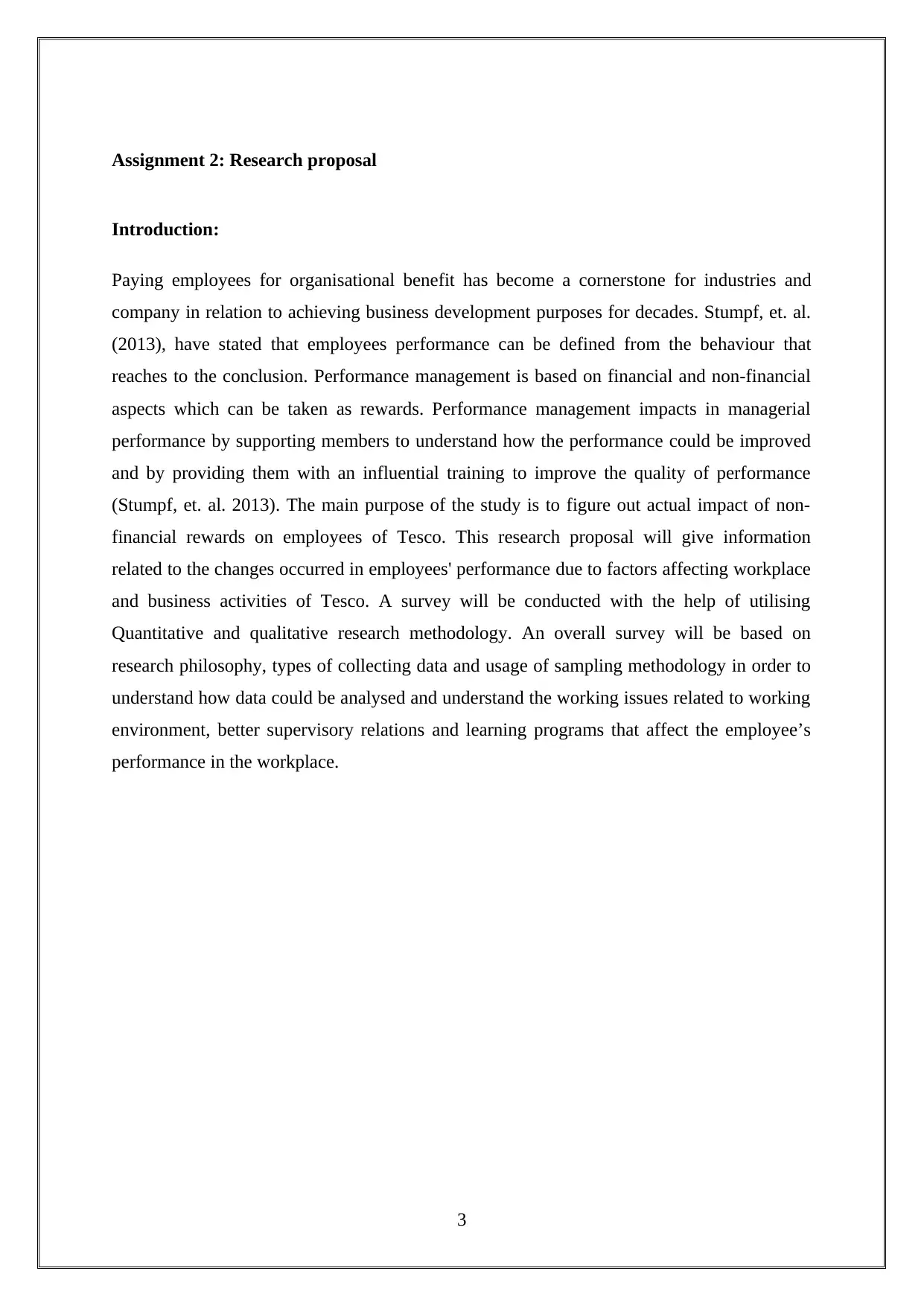
Assignment 2: Research proposal
Introduction:
Paying employees for organisational benefit has become a cornerstone for industries and
company in relation to achieving business development purposes for decades. Stumpf, et. al.
(2013), have stated that employees performance can be defined from the behaviour that
reaches to the conclusion. Performance management is based on financial and non-financial
aspects which can be taken as rewards. Performance management impacts in managerial
performance by supporting members to understand how the performance could be improved
and by providing them with an influential training to improve the quality of performance
(Stumpf, et. al. 2013). The main purpose of the study is to figure out actual impact of non-
financial rewards on employees of Tesco. This research proposal will give information
related to the changes occurred in employees' performance due to factors affecting workplace
and business activities of Tesco. A survey will be conducted with the help of utilising
Quantitative and qualitative research methodology. An overall survey will be based on
research philosophy, types of collecting data and usage of sampling methodology in order to
understand how data could be analysed and understand the working issues related to working
environment, better supervisory relations and learning programs that affect the employee’s
performance in the workplace.
3
Introduction:
Paying employees for organisational benefit has become a cornerstone for industries and
company in relation to achieving business development purposes for decades. Stumpf, et. al.
(2013), have stated that employees performance can be defined from the behaviour that
reaches to the conclusion. Performance management is based on financial and non-financial
aspects which can be taken as rewards. Performance management impacts in managerial
performance by supporting members to understand how the performance could be improved
and by providing them with an influential training to improve the quality of performance
(Stumpf, et. al. 2013). The main purpose of the study is to figure out actual impact of non-
financial rewards on employees of Tesco. This research proposal will give information
related to the changes occurred in employees' performance due to factors affecting workplace
and business activities of Tesco. A survey will be conducted with the help of utilising
Quantitative and qualitative research methodology. An overall survey will be based on
research philosophy, types of collecting data and usage of sampling methodology in order to
understand how data could be analysed and understand the working issues related to working
environment, better supervisory relations and learning programs that affect the employee’s
performance in the workplace.
3
⊘ This is a preview!⊘
Do you want full access?
Subscribe today to unlock all pages.

Trusted by 1+ million students worldwide
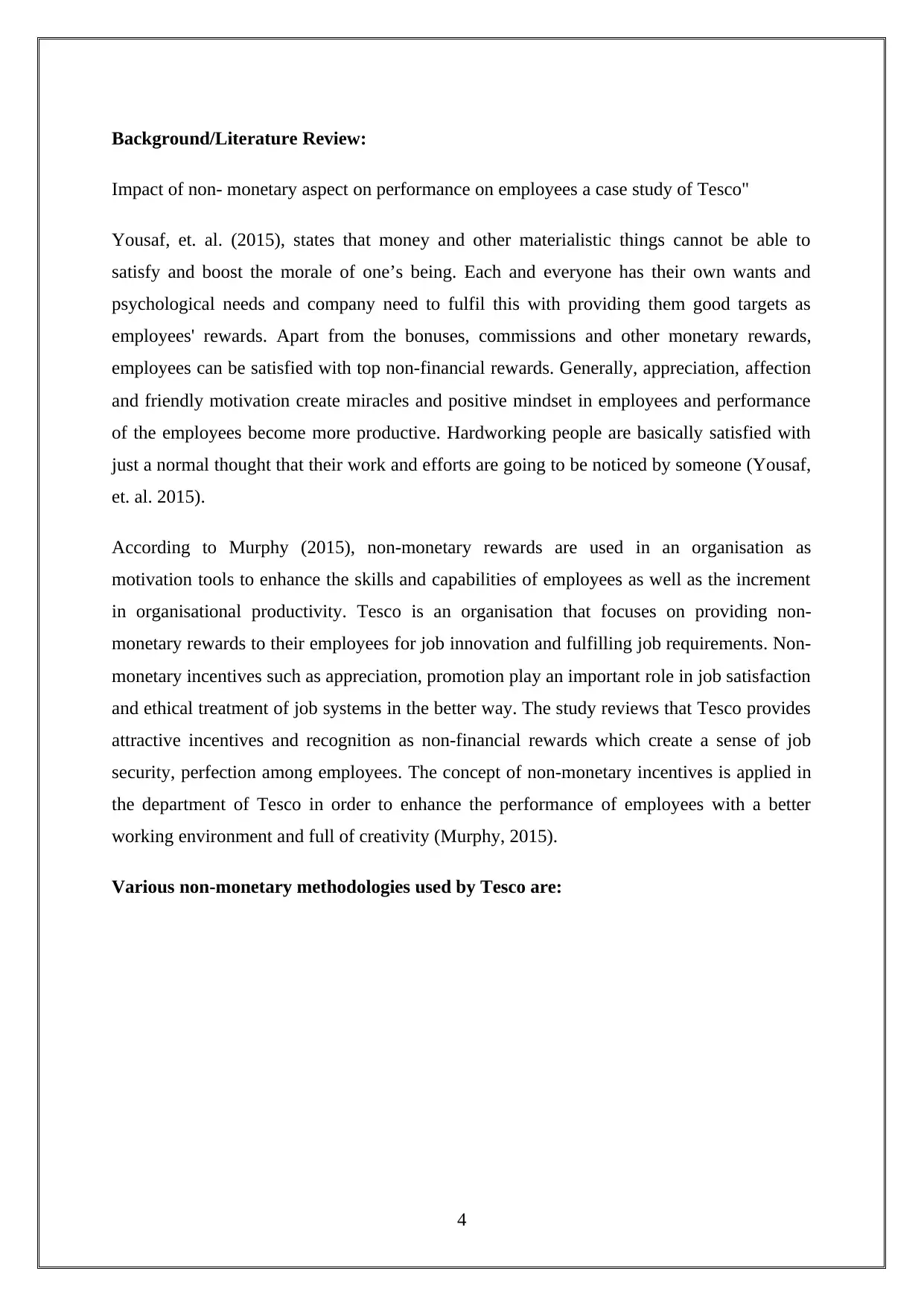
Background/Literature Review:
Impact of non- monetary aspect on performance on employees a case study of Tesco"
Yousaf, et. al. (2015), states that money and other materialistic things cannot be able to
satisfy and boost the morale of one’s being. Each and everyone has their own wants and
psychological needs and company need to fulfil this with providing them good targets as
employees' rewards. Apart from the bonuses, commissions and other monetary rewards,
employees can be satisfied with top non-financial rewards. Generally, appreciation, affection
and friendly motivation create miracles and positive mindset in employees and performance
of the employees become more productive. Hardworking people are basically satisfied with
just a normal thought that their work and efforts are going to be noticed by someone (Yousaf,
et. al. 2015).
According to Murphy (2015), non-monetary rewards are used in an organisation as
motivation tools to enhance the skills and capabilities of employees as well as the increment
in organisational productivity. Tesco is an organisation that focuses on providing non-
monetary rewards to their employees for job innovation and fulfilling job requirements. Non-
monetary incentives such as appreciation, promotion play an important role in job satisfaction
and ethical treatment of job systems in the better way. The study reviews that Tesco provides
attractive incentives and recognition as non-financial rewards which create a sense of job
security, perfection among employees. The concept of non-monetary incentives is applied in
the department of Tesco in order to enhance the performance of employees with a better
working environment and full of creativity (Murphy, 2015).
Various non-monetary methodologies used by Tesco are:
4
Impact of non- monetary aspect on performance on employees a case study of Tesco"
Yousaf, et. al. (2015), states that money and other materialistic things cannot be able to
satisfy and boost the morale of one’s being. Each and everyone has their own wants and
psychological needs and company need to fulfil this with providing them good targets as
employees' rewards. Apart from the bonuses, commissions and other monetary rewards,
employees can be satisfied with top non-financial rewards. Generally, appreciation, affection
and friendly motivation create miracles and positive mindset in employees and performance
of the employees become more productive. Hardworking people are basically satisfied with
just a normal thought that their work and efforts are going to be noticed by someone (Yousaf,
et. al. 2015).
According to Murphy (2015), non-monetary rewards are used in an organisation as
motivation tools to enhance the skills and capabilities of employees as well as the increment
in organisational productivity. Tesco is an organisation that focuses on providing non-
monetary rewards to their employees for job innovation and fulfilling job requirements. Non-
monetary incentives such as appreciation, promotion play an important role in job satisfaction
and ethical treatment of job systems in the better way. The study reviews that Tesco provides
attractive incentives and recognition as non-financial rewards which create a sense of job
security, perfection among employees. The concept of non-monetary incentives is applied in
the department of Tesco in order to enhance the performance of employees with a better
working environment and full of creativity (Murphy, 2015).
Various non-monetary methodologies used by Tesco are:
4
Paraphrase This Document
Need a fresh take? Get an instant paraphrase of this document with our AI Paraphraser
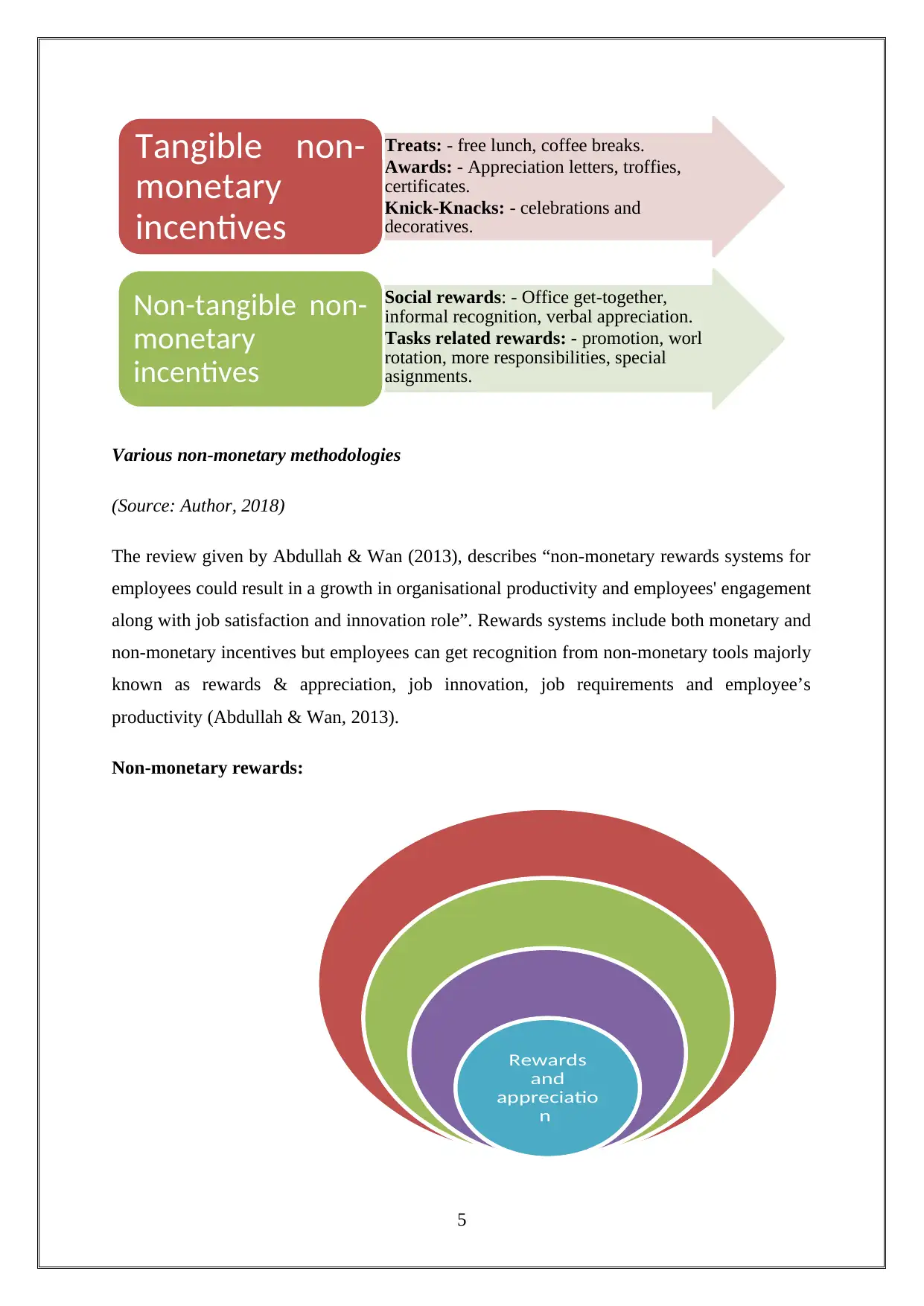
Various non-monetary methodologies
(Source: Author, 2018)
The review given by Abdullah & Wan (2013), describes “non-monetary rewards systems for
employees could result in a growth in organisational productivity and employees' engagement
along with job satisfaction and innovation role”. Rewards systems include both monetary and
non-monetary incentives but employees can get recognition from non-monetary tools majorly
known as rewards & appreciation, job innovation, job requirements and employee’s
productivity (Abdullah & Wan, 2013).
Non-monetary rewards:
5
Treats: - free lunch, coffee breaks.
Awards: - Appreciation letters, troffies,
certificates.
Knick-Knacks: - celebrations and
decoratives.
Tangible non-
monetary
incentives
Social rewards: - Office get-together,
informal recognition, verbal appreciation.
Tasks related rewards: - promotion, worl
rotation, more responsibilities, special
asignments.
Non-tangible non-
monetary
incentives
Job recognition
Job innovation
Employees
productivityRewards
and
appreciatio
n
(Source: Author, 2018)
The review given by Abdullah & Wan (2013), describes “non-monetary rewards systems for
employees could result in a growth in organisational productivity and employees' engagement
along with job satisfaction and innovation role”. Rewards systems include both monetary and
non-monetary incentives but employees can get recognition from non-monetary tools majorly
known as rewards & appreciation, job innovation, job requirements and employee’s
productivity (Abdullah & Wan, 2013).
Non-monetary rewards:
5
Treats: - free lunch, coffee breaks.
Awards: - Appreciation letters, troffies,
certificates.
Knick-Knacks: - celebrations and
decoratives.
Tangible non-
monetary
incentives
Social rewards: - Office get-together,
informal recognition, verbal appreciation.
Tasks related rewards: - promotion, worl
rotation, more responsibilities, special
asignments.
Non-tangible non-
monetary
incentives
Job recognition
Job innovation
Employees
productivityRewards
and
appreciatio
n
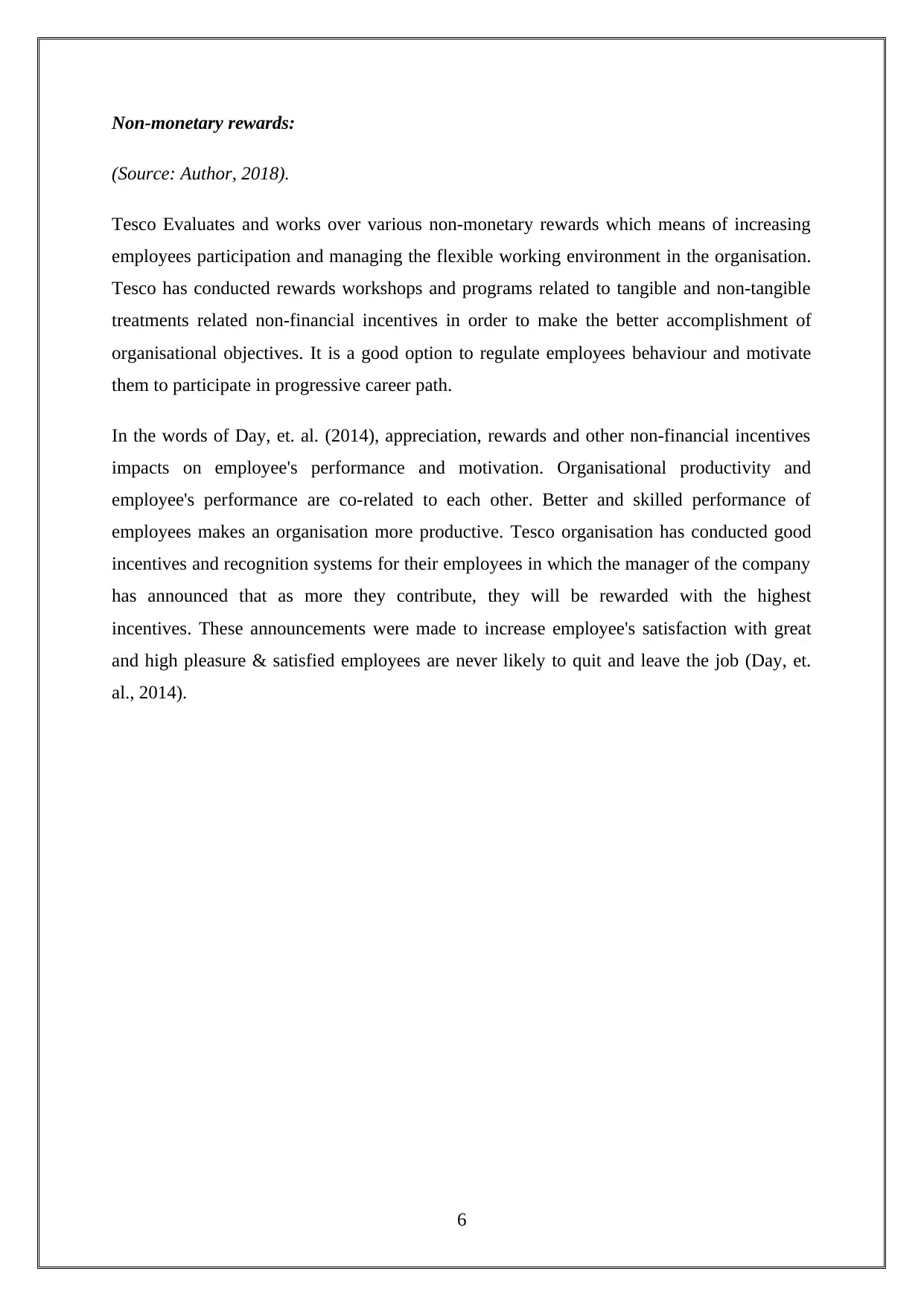
Non-monetary rewards:
(Source: Author, 2018).
Tesco Evaluates and works over various non-monetary rewards which means of increasing
employees participation and managing the flexible working environment in the organisation.
Tesco has conducted rewards workshops and programs related to tangible and non-tangible
treatments related non-financial incentives in order to make the better accomplishment of
organisational objectives. It is a good option to regulate employees behaviour and motivate
them to participate in progressive career path.
In the words of Day, et. al. (2014), appreciation, rewards and other non-financial incentives
impacts on employee's performance and motivation. Organisational productivity and
employee's performance are co-related to each other. Better and skilled performance of
employees makes an organisation more productive. Tesco organisation has conducted good
incentives and recognition systems for their employees in which the manager of the company
has announced that as more they contribute, they will be rewarded with the highest
incentives. These announcements were made to increase employee's satisfaction with great
and high pleasure & satisfied employees are never likely to quit and leave the job (Day, et.
al., 2014).
6
(Source: Author, 2018).
Tesco Evaluates and works over various non-monetary rewards which means of increasing
employees participation and managing the flexible working environment in the organisation.
Tesco has conducted rewards workshops and programs related to tangible and non-tangible
treatments related non-financial incentives in order to make the better accomplishment of
organisational objectives. It is a good option to regulate employees behaviour and motivate
them to participate in progressive career path.
In the words of Day, et. al. (2014), appreciation, rewards and other non-financial incentives
impacts on employee's performance and motivation. Organisational productivity and
employee's performance are co-related to each other. Better and skilled performance of
employees makes an organisation more productive. Tesco organisation has conducted good
incentives and recognition systems for their employees in which the manager of the company
has announced that as more they contribute, they will be rewarded with the highest
incentives. These announcements were made to increase employee's satisfaction with great
and high pleasure & satisfied employees are never likely to quit and leave the job (Day, et.
al., 2014).
6
⊘ This is a preview!⊘
Do you want full access?
Subscribe today to unlock all pages.

Trusted by 1+ million students worldwide
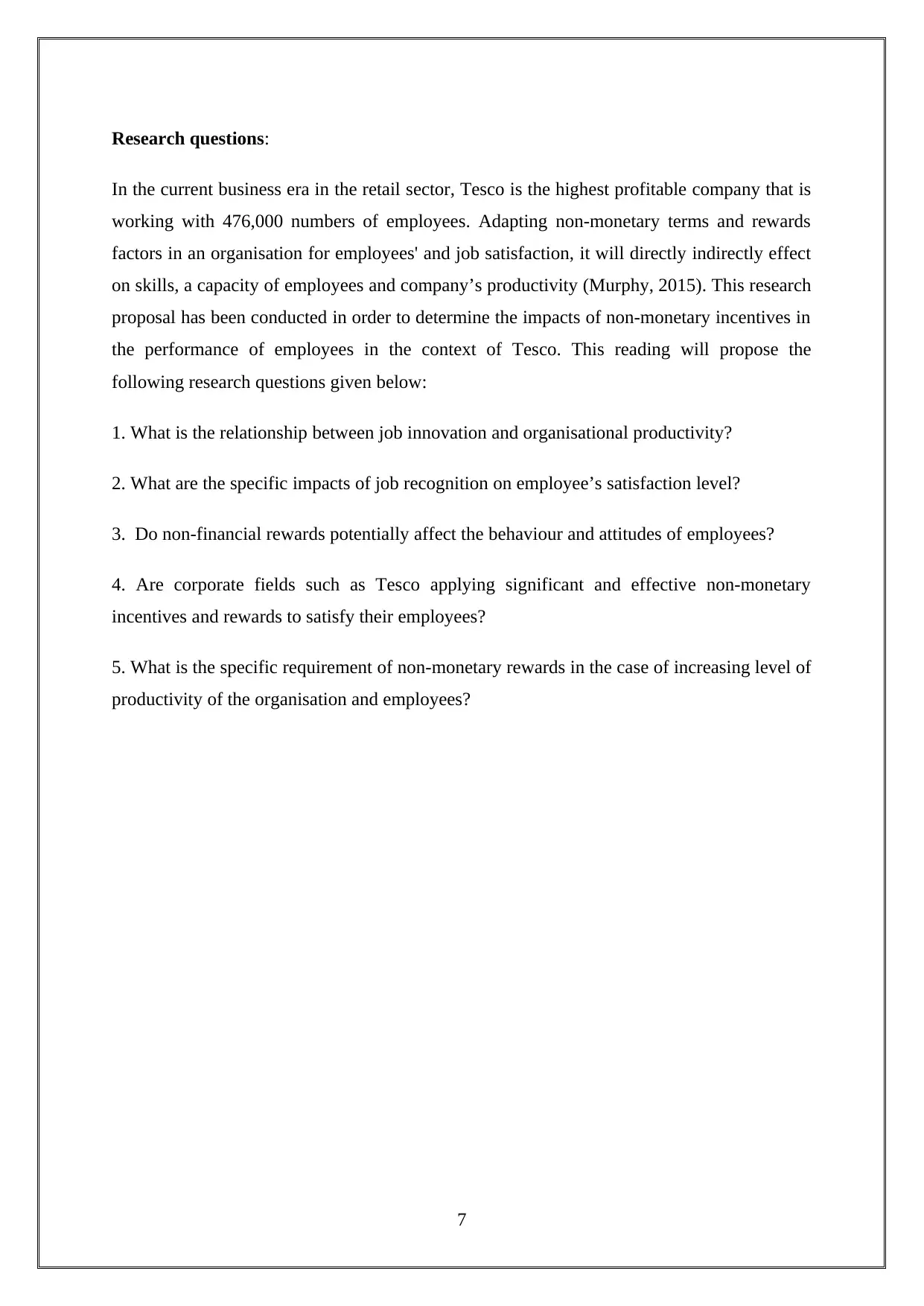
Research questions:
In the current business era in the retail sector, Tesco is the highest profitable company that is
working with 476,000 numbers of employees. Adapting non-monetary terms and rewards
factors in an organisation for employees' and job satisfaction, it will directly indirectly effect
on skills, a capacity of employees and company’s productivity (Murphy, 2015). This research
proposal has been conducted in order to determine the impacts of non-monetary incentives in
the performance of employees in the context of Tesco. This reading will propose the
following research questions given below:
1. What is the relationship between job innovation and organisational productivity?
2. What are the specific impacts of job recognition on employee’s satisfaction level?
3. Do non-financial rewards potentially affect the behaviour and attitudes of employees?
4. Are corporate fields such as Tesco applying significant and effective non-monetary
incentives and rewards to satisfy their employees?
5. What is the specific requirement of non-monetary rewards in the case of increasing level of
productivity of the organisation and employees?
7
In the current business era in the retail sector, Tesco is the highest profitable company that is
working with 476,000 numbers of employees. Adapting non-monetary terms and rewards
factors in an organisation for employees' and job satisfaction, it will directly indirectly effect
on skills, a capacity of employees and company’s productivity (Murphy, 2015). This research
proposal has been conducted in order to determine the impacts of non-monetary incentives in
the performance of employees in the context of Tesco. This reading will propose the
following research questions given below:
1. What is the relationship between job innovation and organisational productivity?
2. What are the specific impacts of job recognition on employee’s satisfaction level?
3. Do non-financial rewards potentially affect the behaviour and attitudes of employees?
4. Are corporate fields such as Tesco applying significant and effective non-monetary
incentives and rewards to satisfy their employees?
5. What is the specific requirement of non-monetary rewards in the case of increasing level of
productivity of the organisation and employees?
7
Paraphrase This Document
Need a fresh take? Get an instant paraphrase of this document with our AI Paraphraser
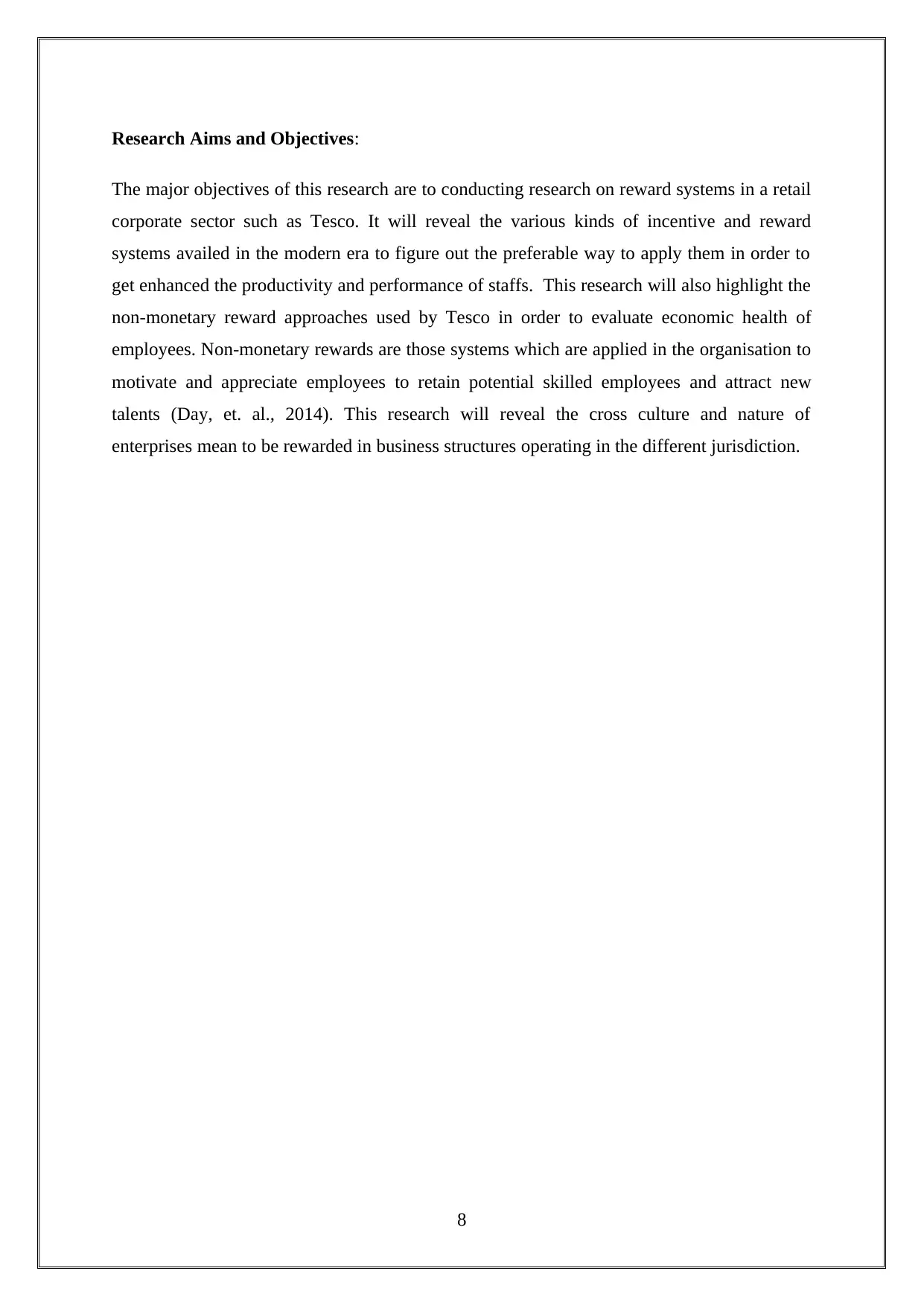
Research Aims and Objectives:
The major objectives of this research are to conducting research on reward systems in a retail
corporate sector such as Tesco. It will reveal the various kinds of incentive and reward
systems availed in the modern era to figure out the preferable way to apply them in order to
get enhanced the productivity and performance of staffs. This research will also highlight the
non-monetary reward approaches used by Tesco in order to evaluate economic health of
employees. Non-monetary rewards are those systems which are applied in the organisation to
motivate and appreciate employees to retain potential skilled employees and attract new
talents (Day, et. al., 2014). This research will reveal the cross culture and nature of
enterprises mean to be rewarded in business structures operating in the different jurisdiction.
8
The major objectives of this research are to conducting research on reward systems in a retail
corporate sector such as Tesco. It will reveal the various kinds of incentive and reward
systems availed in the modern era to figure out the preferable way to apply them in order to
get enhanced the productivity and performance of staffs. This research will also highlight the
non-monetary reward approaches used by Tesco in order to evaluate economic health of
employees. Non-monetary rewards are those systems which are applied in the organisation to
motivate and appreciate employees to retain potential skilled employees and attract new
talents (Day, et. al., 2014). This research will reveal the cross culture and nature of
enterprises mean to be rewarded in business structures operating in the different jurisdiction.
8
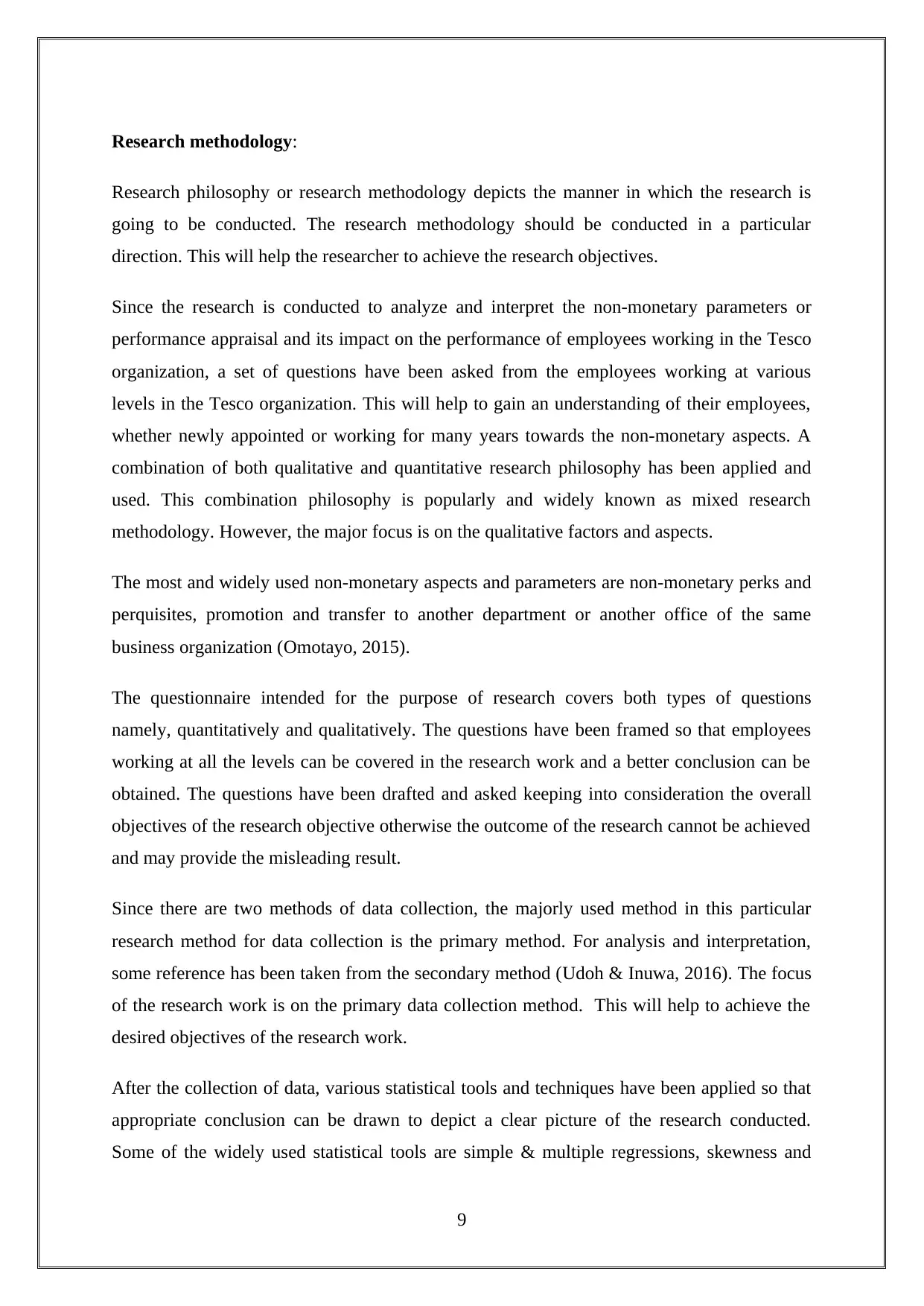
Research methodology:
Research philosophy or research methodology depicts the manner in which the research is
going to be conducted. The research methodology should be conducted in a particular
direction. This will help the researcher to achieve the research objectives.
Since the research is conducted to analyze and interpret the non-monetary parameters or
performance appraisal and its impact on the performance of employees working in the Tesco
organization, a set of questions have been asked from the employees working at various
levels in the Tesco organization. This will help to gain an understanding of their employees,
whether newly appointed or working for many years towards the non-monetary aspects. A
combination of both qualitative and quantitative research philosophy has been applied and
used. This combination philosophy is popularly and widely known as mixed research
methodology. However, the major focus is on the qualitative factors and aspects.
The most and widely used non-monetary aspects and parameters are non-monetary perks and
perquisites, promotion and transfer to another department or another office of the same
business organization (Omotayo, 2015).
The questionnaire intended for the purpose of research covers both types of questions
namely, quantitatively and qualitatively. The questions have been framed so that employees
working at all the levels can be covered in the research work and a better conclusion can be
obtained. The questions have been drafted and asked keeping into consideration the overall
objectives of the research objective otherwise the outcome of the research cannot be achieved
and may provide the misleading result.
Since there are two methods of data collection, the majorly used method in this particular
research method for data collection is the primary method. For analysis and interpretation,
some reference has been taken from the secondary method (Udoh & Inuwa, 2016). The focus
of the research work is on the primary data collection method. This will help to achieve the
desired objectives of the research work.
After the collection of data, various statistical tools and techniques have been applied so that
appropriate conclusion can be drawn to depict a clear picture of the research conducted.
Some of the widely used statistical tools are simple & multiple regressions, skewness and
9
Research philosophy or research methodology depicts the manner in which the research is
going to be conducted. The research methodology should be conducted in a particular
direction. This will help the researcher to achieve the research objectives.
Since the research is conducted to analyze and interpret the non-monetary parameters or
performance appraisal and its impact on the performance of employees working in the Tesco
organization, a set of questions have been asked from the employees working at various
levels in the Tesco organization. This will help to gain an understanding of their employees,
whether newly appointed or working for many years towards the non-monetary aspects. A
combination of both qualitative and quantitative research philosophy has been applied and
used. This combination philosophy is popularly and widely known as mixed research
methodology. However, the major focus is on the qualitative factors and aspects.
The most and widely used non-monetary aspects and parameters are non-monetary perks and
perquisites, promotion and transfer to another department or another office of the same
business organization (Omotayo, 2015).
The questionnaire intended for the purpose of research covers both types of questions
namely, quantitatively and qualitatively. The questions have been framed so that employees
working at all the levels can be covered in the research work and a better conclusion can be
obtained. The questions have been drafted and asked keeping into consideration the overall
objectives of the research objective otherwise the outcome of the research cannot be achieved
and may provide the misleading result.
Since there are two methods of data collection, the majorly used method in this particular
research method for data collection is the primary method. For analysis and interpretation,
some reference has been taken from the secondary method (Udoh & Inuwa, 2016). The focus
of the research work is on the primary data collection method. This will help to achieve the
desired objectives of the research work.
After the collection of data, various statistical tools and techniques have been applied so that
appropriate conclusion can be drawn to depict a clear picture of the research conducted.
Some of the widely used statistical tools are simple & multiple regressions, skewness and
9
⊘ This is a preview!⊘
Do you want full access?
Subscribe today to unlock all pages.

Trusted by 1+ million students worldwide
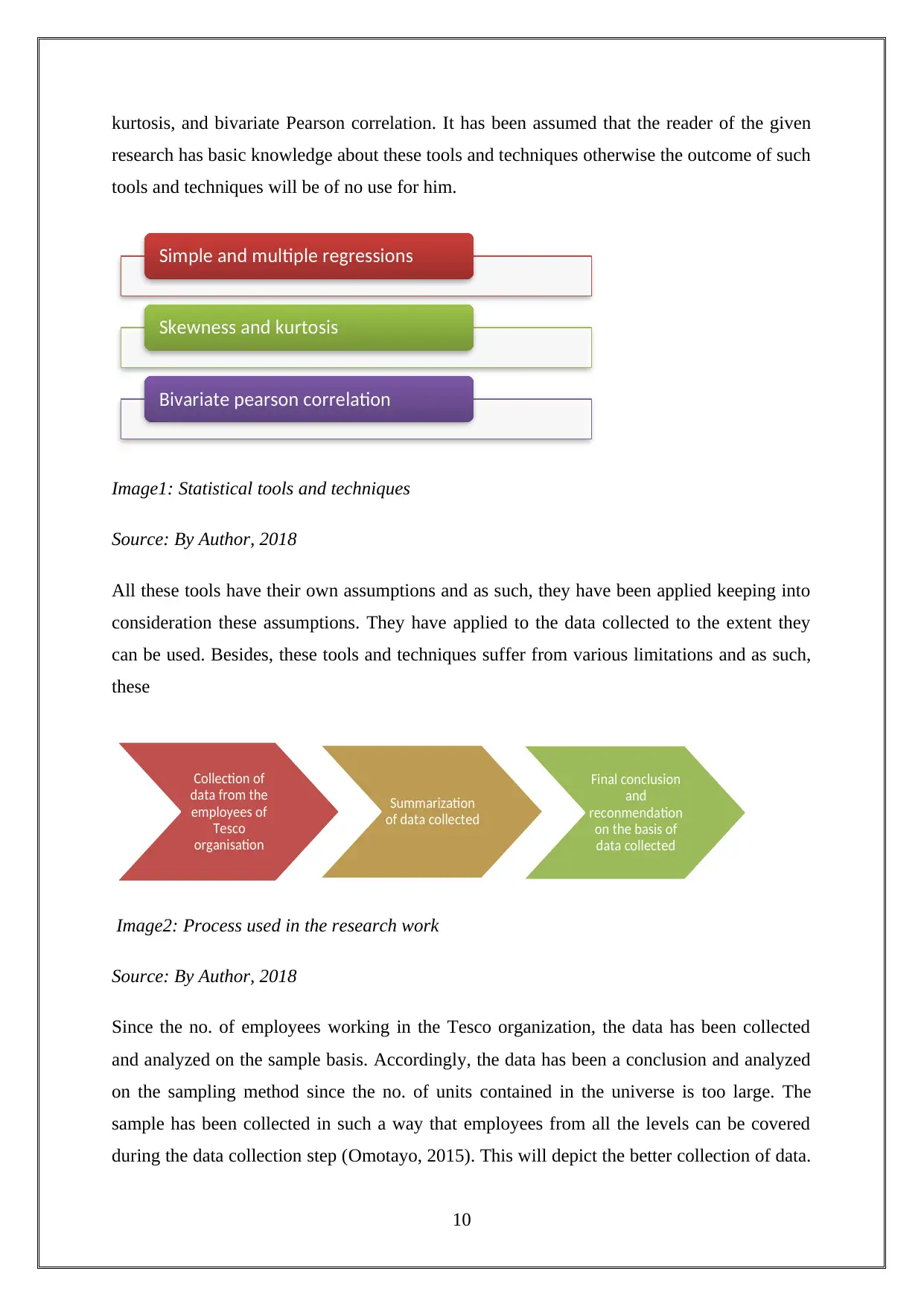
kurtosis, and bivariate Pearson correlation. It has been assumed that the reader of the given
research has basic knowledge about these tools and techniques otherwise the outcome of such
tools and techniques will be of no use for him.
Image1: Statistical tools and techniques
Source: By Author, 2018
All these tools have their own assumptions and as such, they have been applied keeping into
consideration these assumptions. They have applied to the data collected to the extent they
can be used. Besides, these tools and techniques suffer from various limitations and as such,
these
Image2: Process used in the research work
Source: By Author, 2018
Since the no. of employees working in the Tesco organization, the data has been collected
and analyzed on the sample basis. Accordingly, the data has been a conclusion and analyzed
on the sampling method since the no. of units contained in the universe is too large. The
sample has been collected in such a way that employees from all the levels can be covered
during the data collection step (Omotayo, 2015). This will depict the better collection of data.
10
Simple and multiple regressions
Skewness and kurtosis
Bivariate pearson correlation
Collection of
data from the
employees of
Tesco
organisation
Summarization
of data collected
Final conclusion
and
reconmendation
on the basis of
data collected
research has basic knowledge about these tools and techniques otherwise the outcome of such
tools and techniques will be of no use for him.
Image1: Statistical tools and techniques
Source: By Author, 2018
All these tools have their own assumptions and as such, they have been applied keeping into
consideration these assumptions. They have applied to the data collected to the extent they
can be used. Besides, these tools and techniques suffer from various limitations and as such,
these
Image2: Process used in the research work
Source: By Author, 2018
Since the no. of employees working in the Tesco organization, the data has been collected
and analyzed on the sample basis. Accordingly, the data has been a conclusion and analyzed
on the sampling method since the no. of units contained in the universe is too large. The
sample has been collected in such a way that employees from all the levels can be covered
during the data collection step (Omotayo, 2015). This will depict the better collection of data.
10
Simple and multiple regressions
Skewness and kurtosis
Bivariate pearson correlation
Collection of
data from the
employees of
Tesco
organisation
Summarization
of data collected
Final conclusion
and
reconmendation
on the basis of
data collected
Paraphrase This Document
Need a fresh take? Get an instant paraphrase of this document with our AI Paraphraser
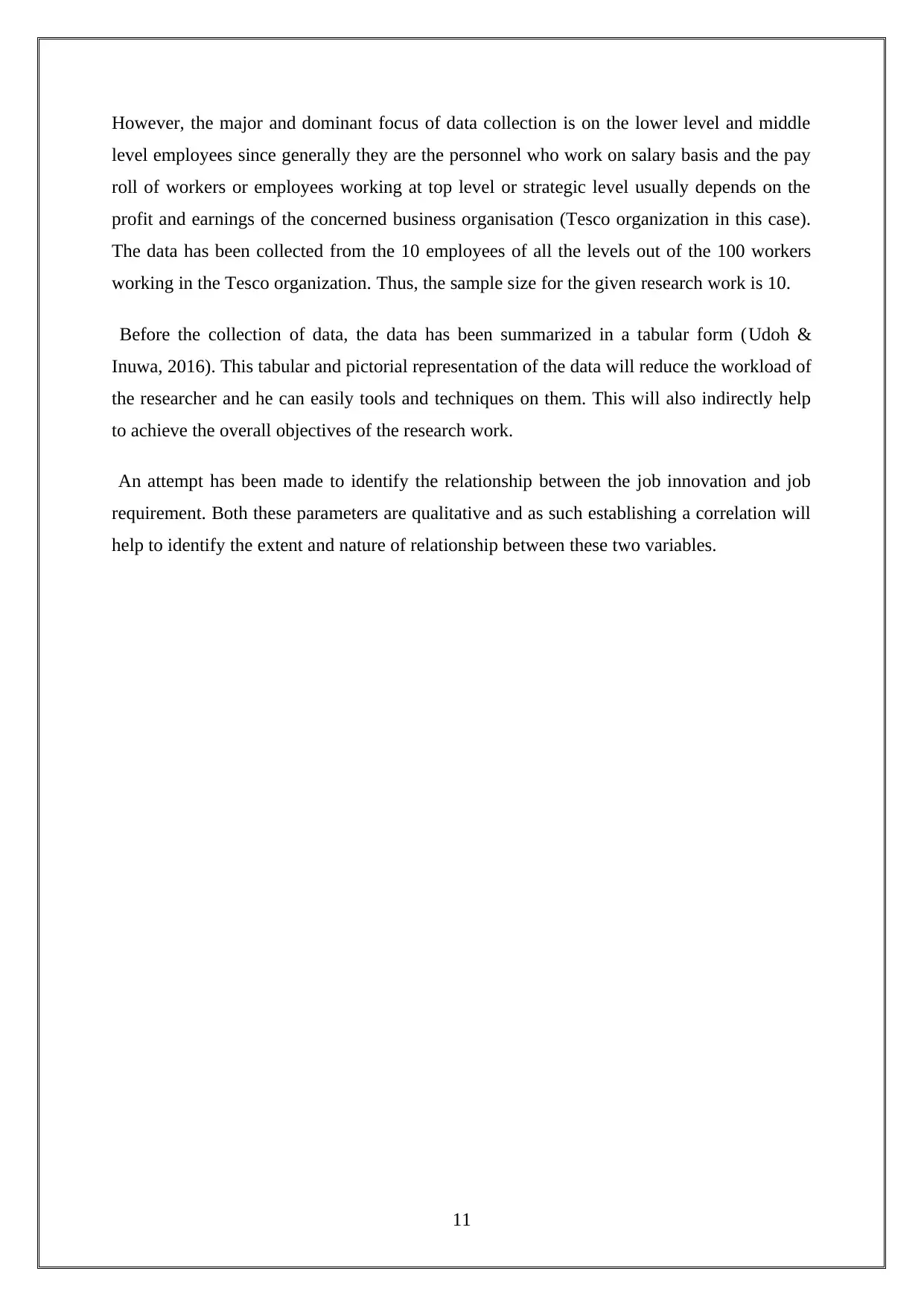
However, the major and dominant focus of data collection is on the lower level and middle
level employees since generally they are the personnel who work on salary basis and the pay
roll of workers or employees working at top level or strategic level usually depends on the
profit and earnings of the concerned business organisation (Tesco organization in this case).
The data has been collected from the 10 employees of all the levels out of the 100 workers
working in the Tesco organization. Thus, the sample size for the given research work is 10.
Before the collection of data, the data has been summarized in a tabular form (Udoh &
Inuwa, 2016). This tabular and pictorial representation of the data will reduce the workload of
the researcher and he can easily tools and techniques on them. This will also indirectly help
to achieve the overall objectives of the research work.
An attempt has been made to identify the relationship between the job innovation and job
requirement. Both these parameters are qualitative and as such establishing a correlation will
help to identify the extent and nature of relationship between these two variables.
11
level employees since generally they are the personnel who work on salary basis and the pay
roll of workers or employees working at top level or strategic level usually depends on the
profit and earnings of the concerned business organisation (Tesco organization in this case).
The data has been collected from the 10 employees of all the levels out of the 100 workers
working in the Tesco organization. Thus, the sample size for the given research work is 10.
Before the collection of data, the data has been summarized in a tabular form (Udoh &
Inuwa, 2016). This tabular and pictorial representation of the data will reduce the workload of
the researcher and he can easily tools and techniques on them. This will also indirectly help
to achieve the overall objectives of the research work.
An attempt has been made to identify the relationship between the job innovation and job
requirement. Both these parameters are qualitative and as such establishing a correlation will
help to identify the extent and nature of relationship between these two variables.
11
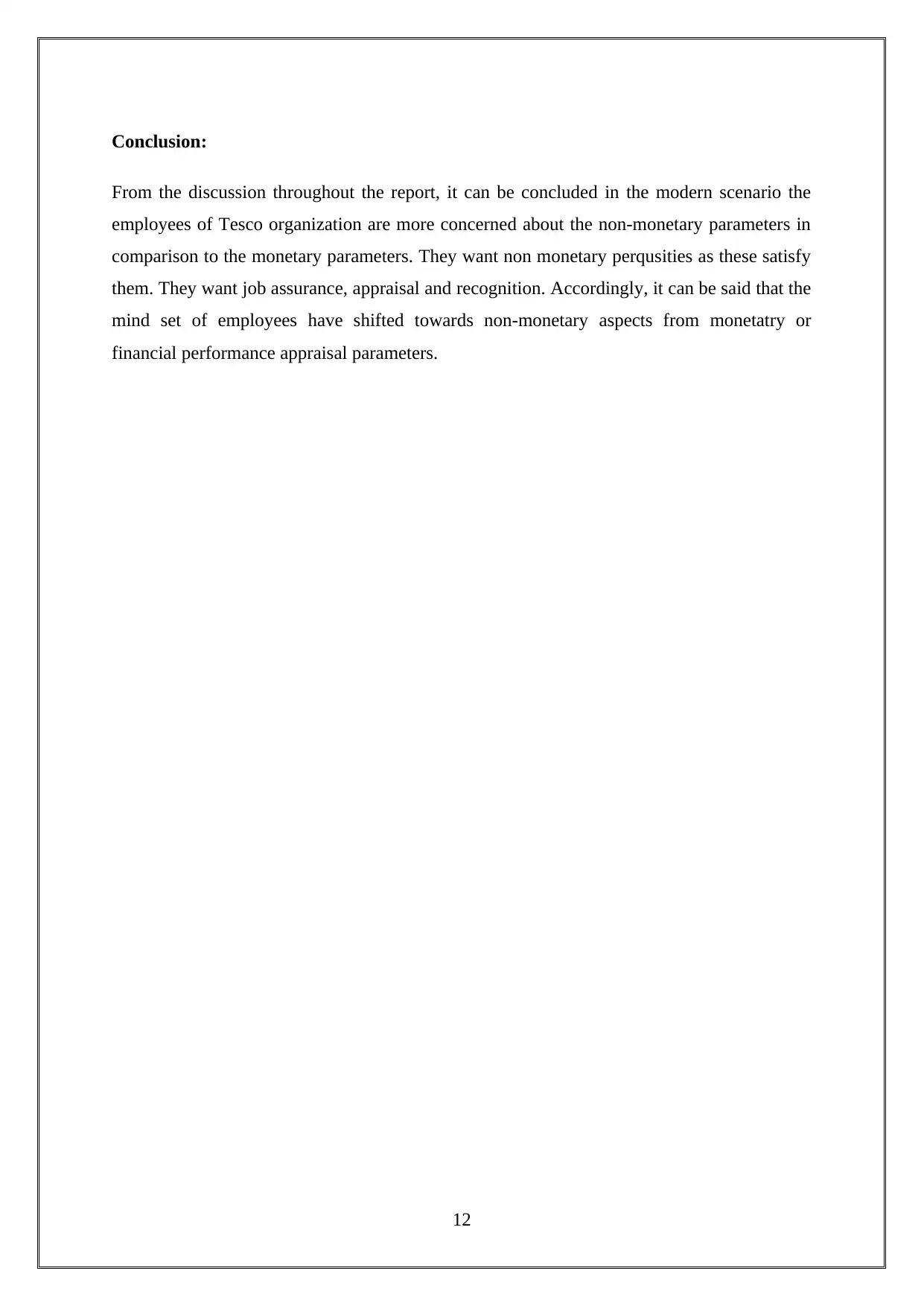
Conclusion:
From the discussion throughout the report, it can be concluded in the modern scenario the
employees of Tesco organization are more concerned about the non-monetary parameters in
comparison to the monetary parameters. They want non monetary perqusities as these satisfy
them. They want job assurance, appraisal and recognition. Accordingly, it can be said that the
mind set of employees have shifted towards non-monetary aspects from monetatry or
financial performance appraisal parameters.
12
From the discussion throughout the report, it can be concluded in the modern scenario the
employees of Tesco organization are more concerned about the non-monetary parameters in
comparison to the monetary parameters. They want non monetary perqusities as these satisfy
them. They want job assurance, appraisal and recognition. Accordingly, it can be said that the
mind set of employees have shifted towards non-monetary aspects from monetatry or
financial performance appraisal parameters.
12
⊘ This is a preview!⊘
Do you want full access?
Subscribe today to unlock all pages.

Trusted by 1+ million students worldwide
1 out of 14
Related Documents
Your All-in-One AI-Powered Toolkit for Academic Success.
+13062052269
info@desklib.com
Available 24*7 on WhatsApp / Email
![[object Object]](/_next/static/media/star-bottom.7253800d.svg)
Unlock your academic potential
Copyright © 2020–2025 A2Z Services. All Rights Reserved. Developed and managed by ZUCOL.





